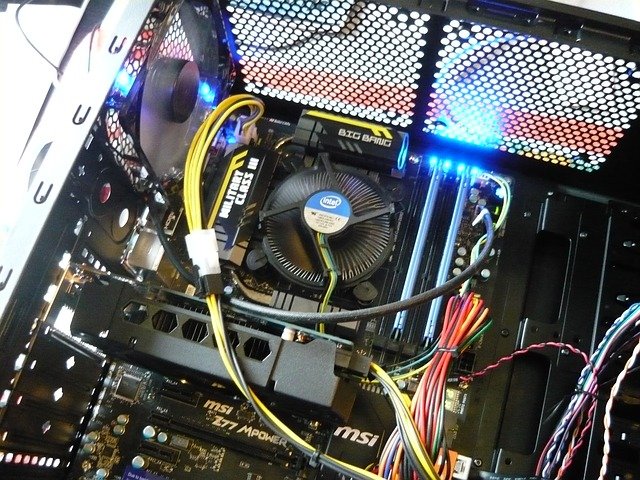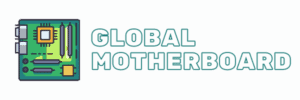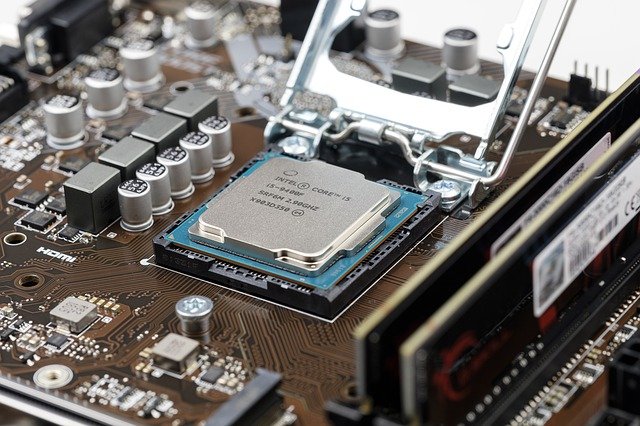The modular motherboard concept that we are familiar with and familiar with today was created in the 1980s by Patty McHugh, an IBM engineer. Its development made it possible to greatly simplify the way in which the various hardware components interacted and, therefore, also facilitated the design of computers.
Today, motherboards are an indispensable element of computers and a multitude of electronic devices, since the rest of the components are connected to them. Logically, if you need to acquire one, it is important that you make sure that it is compatible with each one of them. And that it offers enough expansion options for the future.
The most important
- The motherboard is a fundamental element of computers, since the rest of the computer components are connected to it, from the microprocessor to the graphics card through the RAM ( Random Access Memory , in English), the monitor or the computer. Same keyboard.
- When choosing the motherboard, first you have to make sure that it is compatible with the processor that you are going to install. You not only have to consider the manufacturer, but also the processor model itself.
- It is important that you are familiar with the characteristics of motherboards to choose the right one to replace the one you have in your computer or to mount your own PC. Therefore, it is essential that you know elements such as the chipset, the CPU socket ( Central Processing Unit , in English), the RAM memory slots, or the connection ports, since they will serve as purchase criteria.
Best Motherboard For Workstation PC
Below are the top and best motherboards for workstation pc which are high in performance.
ASUS TUF Gaming Z590-Plus
About this item
- ASUS TUF Gaming Z590-Plus Gaming motherboard is designed to support latest Intel Socket LGA 1200 for 11th Gen Intel Core processors & 10th Gen Intel Core. The board is PCIe 4.0 Ready supporting up to 128GB DDR4 5133MHz(OC) of memory and Intel Turbo Boost Technology.
- With enlarged VRM heatsink, PCH fanless heatsink, M.2 heatsinks, hybrid fan headers and Fan Xpert 4 utility the board is having an optimized thermal design. The 14+2 DrMOS power stages, six-layer PCB, ProCool sockets, military-grade TUF components and Digi+ VRM provides maximum durability.
- Enjoy the best online gaming experience with Intel 2.5 Gb Ethernet, TUF LANGuard and TurboLAN technology. For next-gen connectivity its equipped with PCIe 4.0, USB 3.2 Gen 2×2 Type-C, front panel header for USB 3.2 Gen 1 Type-C and Thunderbolt 4 support.
- The board comes with additional tweaks like Q-Latch which helps in easy installation or removal of an M.2 SSD without the need for specific tools, A SafeSlot which integrates fortifying metal for an inherently stronger slot for your graphics card.
- ASUS Aura offers full RGB lighting control with a variety of functional presets for the built-in RGB LEDs as well as strips connected to the onboard RGB headers. The Realtek S1200A codec gives pristine audio quality with unprecedented 108 dB signal-to-noise ratio for stereo line out and 103 dB SNR for line in.
ASUS ROG Strix B550-F Gaming
About this item
- AMD AM4 Socket and PCIe 4. 0: The perfect pairing for 3rd Gen AMD Ryzen CPUs
- Robust Power Design: 12+2 DrMOS power stages with high-quality alloy chokes and durable capacitors to provide reliable power for the latest high-core-count AMD CPUs
- Optimized Thermal Solution: Fanless VRM and chipset heatsinks with ASUS Stack Cool 3+ design keep your system running reliably under heavy load by enhancing passive cooling capacity for critical onboard components.
- High-performance Gaming Networking: On-board WiFi 6 (802. 11ax), Bluetooth V5. 1 and 2. 5 Gb LAN with ASUS LANGuard
- Best Gaming Connectivity: Supports HDMI 2. 1 (4K@60HZ) and DisplayPort 1. 2 output, plus dual M. 2 slots (NVMe SSD)—one with PCIe 4. 0 x4 connectivity, USB 3. 2 Gen 2 Type-C port and Thunderbolt 3 header
ASRock B450M Steel Legend
About this item
- AMD AM4 Socket ; 3rd Generation & 2nd Generation Ryzen supported Latest BIOS
- Supports DDR4 3533+ (OC)
- 1 PCIe 3.0 x16, 1 PCIe 2.0 x16, 1 PCIe 2.0 x1
- 7.1 CH HD Audio (Realtek ALC892 Audio Codec), Nichicon Fine Gold Series Audio Caps
- 4 SATA3, 1 Ultra M.2 (PCIe Gen3 x4), 1 M.2 (SATA3)
MSI MPG Z490
About this item
- Supports 10th Gen Intel Core / Pentium Celeron processors for LGA 1200 socket
- Supports DDR4 Memory, up to 4800(OC) MHz
- Ready 4 the Future: Support Lightning Gen 4 Solution for the future
- 2.5G LAN with LAN Manager and Intel Wi-Fi 6 AX Solution: Upgraded network solution for professional and multimedia use.
- MYSTIC LIGHT: 16.8 million colors / 29 effects controlled in one click. MYSTIC LIGHT EXTENSION supports both RGB and RAINBOW LED strip.
MSI MEG Z590 GODLIKE
About this item
- Supports 11th and 10th Gen Intel Core/Pentium/Celeron processors for LGA 1200 Socket
- EXTREME 11TH GEN CORE PERFORMANCE – The MEG Z590 GODLIKE pushes the known limits of the Intel Z590 chipset with a Direct 20 Phase 90A SPS VRM
- Preinstalled fans and advanced heatsinks (with 8mm heatpipe & wavy fins) keep temperatures low, while an 8-layer PCB base with full aluminium backplate and DIMM/PCIe x16 steel armour provides premium durability
- Dual PCIe 4.0 x16 slots support 2-way NVIDIA SLI & 3-way AMD CrossFire technology (via tertiary PCIe 3.0 x16 slot), quad-DIMM with DDR4-Boost architecture enable faster SDRAM for overclocking (5600MHz/OC)
- Storage includes 1 x M.2 Gen4 x4 64Gb/s and 3 x M.2 Gen3 x4 32Gb/s slots (supports Intel Optane) each with double-side Shield Frozr to prevent thermal throttling
Source: msi.com
Buying Guide: What You Should Know About Motherboards
If you need to buy a motherboard, it is essential that you consider a number of important issues. After all, there is a wide variety of different models, designed for different user profiles. Therefore, in this section we are going to try to clarify the main questions you may have about motherboards.
What Exactly Is A Motherboard?
The motherboard, motherboard, system board or motherboard in English is a printed circuit that has the function of connecting and controlling all the components of a computer. In a way, it can be considered to be your spine. Hence, its great importance in its performance. They are usually named according to the chipset that they integrate.
What Are The Possible Reasons To Buy A Motherboard?
The reasons why you may need to buy a motherboard are mainly three: replace the motherboard of your computer to improve its performance, replace it because it is failing or has definitively damaged, or purchase one to mount a new computer component by component.
In any case, before choosing a motherboard, it is important that you decide if you want one that offers you a long useful life or one that delivers in the short term. Of course, the former will require a greater financial investment, but they also ensure the possibility of improving or expanding any of the components in the future.
What Are The Advantages Of Buying A Motherboard To Mount A Component To Component Computer?
Assembling a computer component by component offers a number of important advantages. For starters, it is usually cheaper than equipment that is already assembled as standard. In addition, it allows you to choose which components you want to install on your computer and invest more in those that you consider most important for the use you are going to make of it.
It may also be that you want to take advantage of a component of your old computer, that you want to take advantage of an offer or that you even want to buy some second-hand. Of course, designing your own PC requires a minimum knowledge of hardware and / or that you carry out a research process to find the right components.
What Are The Basic Elements Of A Motherboard?
The basic boards have a number of basic elements, such as the ATX power connector, the CPU socket, the slots for the RAM memory modules, the PCI and PCI Express expansion slots, the storage connectors, the connectors PS / 2, graphics connectors, CMOS battery, USB and network ports, BIOS, and chipset.
- ATX power connector : through which the main power comes from the source to the motherboard.
- CPU socket : it is the place where the processor is connected. It can be for Intel or AMD processors.
- RAM memory slots : In general, for desktop computers there are usually between two and eight slots. In the case of laptop boards, this is usually the only part of the board that includes expansion options.
- PCI and PCI Express expansion slots : used to add new components to the computer, such as graphics cards or sound cards. PCI slots are considered obsolete, so it is becoming less current to find boards that have them.
- Storage connectors : this is where you connect hard drives, SSD drives, DVD readers and writers, among others.
- PS / 2 connectors : to connect keyboards and mice.
- Graphic connectors : which are used to connect monitors. It is possible to find them as DisplayPort , HDMI, DVI and even VGA.
- USB ports : where you can connect from peripherals such as mice and printers to USB memory sticks or external hard drives.
- Network ports – This is where you connect Ethernet cables to enjoy a wired network.
- BIOS ( Basic Input / Output System , in English) : which is a read-only memory in which the software that controls the hardware is located and that operates as an interface between the operating system and the hardware of the computer.
- Chipset : composed of a set of small circuits, which are responsible for coordinating the flow of information to and from the different key components of the equipment.
- CMOS ( Complimentary Metal Oxide Semiconductor ) battery: This is a lithium battery that supplies the energy needed to power the BIOS.

What Motherboard Formats Are There?
Today, there are dozens of different motherboard formats. Each one is designed for a type of computer. However, the three most common are: the full-size (ATX), the mid-size (micro ATX) or the small (mini ITX) form factor. We have prepared a complete table explaining its main characteristics.
Of course, the larger the size of the motherboard, the more connectors and expansion possibilities it will have. In addition, it is important that you bear in mind that the plate format determines the size of the PC case and, therefore, also affects the cooling system that you can mount.
Why Would You Be Interested In Having Your Motherboard Allow You To Overclock ?
Surely, you have heard of overclocking and wonder what it is and what advantages it offers. To begin with, it is important that you are clear that overclocking is a practice that can be done both in the processor, in the RAM and in the graphics card. What is sought with this technique is to increase the clock speed or the working frequency of a component.
What you do is increase your performance and speed. In the case of processors, both Intel and AMD already have a technology that allows them to increase their frequency automatically. Of course, in order to carry out this practice it is important that the processor and the board are unlocked and allow overclocking .







